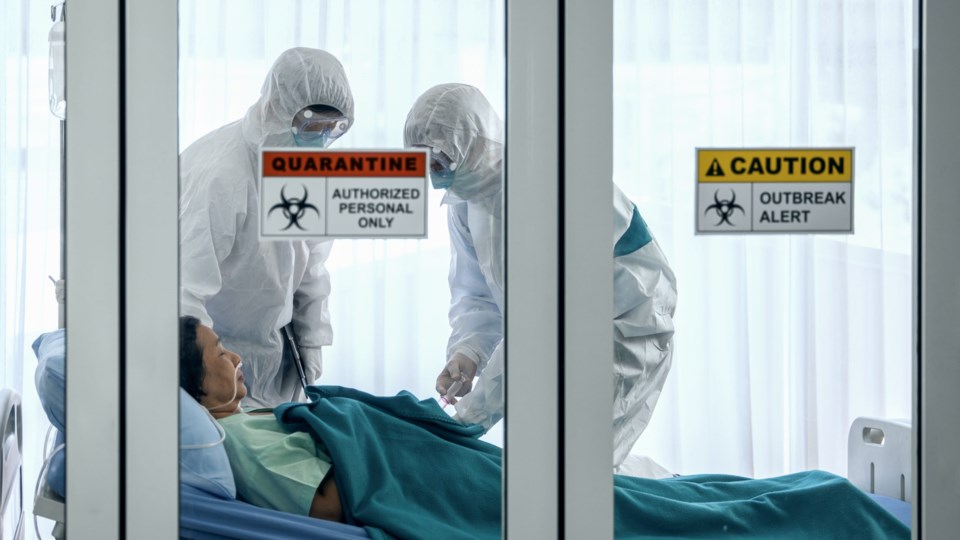It usually starts with shortness of breath. Older adults and people with pre-existing medical conditions are most likely to develop a fever, followed, in the most dire cases, by chest pain, drowsiness, and more.
"It was over 101 for about four straight days," Sara Tucker, 33, told WFAA in March. "Just terrible body aches, the worst imaginable, I sometimes just sat in the tub and cried because there was just no relief. I feel like my body has been through a battle, like someone has just beaten me up.
"As hard as it's been for me, I can't imagine someone who is elderly or has asthma or any sort of underlying health issue. There's been times where I've asked people, 'I'm going to be OK, right? Because I felt so sick that it was scary."
To be hospitalized for COVID-19 has become an ordeal, and in the weeks leading up to Thanksgiving, Collin County COVID-19 hospitalizations are spiking, following the trends in Texas and the United States.
On Nov. 17 Collin County had 322 patients hospitalized, a record high, with 23,381 confirmed cases and 238 deaths, according to Johns Hopkins.
Today, 275 people are hospitalized.
Collin County officials say they were expecting these numbers. Darrell Willis, a Health Care Services spokesperson, says that they have been preparing for this kind of picture.
“We were expecting this—hoping it wouldn’t happen, but not surprised,” he says. “This spike is one of those things happening statewide and countrywide.”
Willis confirms that Collin County has 2,702 beds, and typically, problems occur and resources become strained when COVID-19 patients occupy 15 percent of hospital beds. “At 15 percent threshold, we start to raise eyebrows,” he says.
For Collin County, that would be 405 beds. Though the county no longer displays full COVID-19 data, they receive hospitalization information from local hospitals daily.
But Willis attributes rising numbers, in part, to COVID-19 fatigue.
“People have become fatigued to the guidelines we’ve set out and CDC has set out," he says. "Some people aren’t not being as careful as they could or should be.”
Across the country, 83,779 people are in the hospital, a record high for the country. Of that population, 16,212 people are in the ICU, and 5,233 are on a ventilator. COVID-19 hospitalizations had never broken 60,000 before November.
Collin County Health Care Services gives advice and provides resources to the community, rather than distributing medical care. Since the pandemic started, they have taken a steady number of calls from daycares, public schools, businesses, and individuals who have a positive COVID-19 test and want to know how to proceed.
As the holidays approach, Willis reminds citizens to follow CDC guidelines. He adds that through Collin County CARES, the county can partner with certain providers for underinsured and uninsured individuals that need to be tested.
“Limit contact with individuals outside of the household," he adds. "We’re anticipating an increase in cases.”
CDC Holiday Guidelines
- Community levels of COVID-19 – Family and friends should consider the number of COVID-19 cases in their community and in the community where they plan to celebrate when deciding whether to host or attend a gathering. Collin County COVID-19 hospitalizations can be found here.
- Exposure during travel – Travelers use caution at airports, bus stations, train stations, public transport, gas stations, and rest stops.
- Location of the gathering – Indoor gatherings, especially those with poor ventilation (for example, small enclosed spaces with no outside air), pose more risk than outdoor gatherings.
- Duration of the gathering – Gatherings that last longer pose more risk than shorter gatherings. Being within 6 feet of someone who has COVID-19 for a cumulative total of 15 minutes or more greatly increases the risk of becoming sick and requires a 14-day quarantine.
- Number and crowding of people at the gathering – Gatherings with more people pose more risk than gatherings with fewer people. CDC does not have a limit or recommend a specific number of attendees for gatherings. Determine the size of a holiday gathering based on the ability of attendees from different households to stay 6 feet (2 arm lengths) apart, wear masks, wash hands, and follow state, local, territorial, or tribal health and safety laws, rules, and regulations.
- Behaviors of attendees prior to the gathering – Individuals who did not consistently adhere to social distancing (staying at least 6 feet apart), mask wearing, handwashing, and other prevention behaviors pose more risk than those who consistently practiced these safety measures.
- Behaviors of attendees during the gathering – Institute some safety measures like mask wearing, social distancing, and handwashing.




